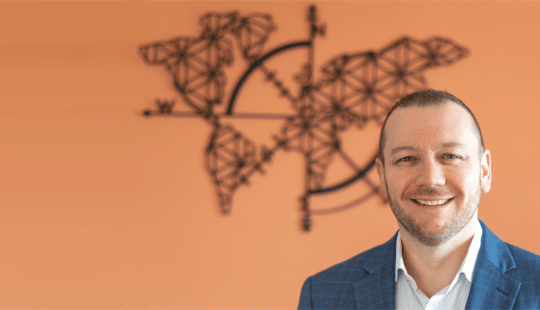Leadership is a tricky phenomenon to nail down. Everybody knows it’s important, but few can define it. It has inspired many great quotations: “A leader is one who knows the way, goes the way, and shows the way,” wrote John C. Maxwell, while Simon Sinek states: “Leaders are the ones willing to take care of the people around them. They can exist in any level or department of an organisation. We call someone ‘leader’ because they took the risk to express uncertainty, ask for help, or head towards danger before anyone else.”
Today, leadership has never been so important as we learn to live without the regular in-person interactions of office life. But that can be a positive too as hierarchies are reduced and as more people have the opportunity to input ideas.
Having recently taken on my new leadership role in the UK and Ireland for SAP, I wanted to share a few insights about how I approach the leadership challenge.
Create a sense of purpose and belonging
- Be aspirational about a future state you wish to see materialise. At SAP, we feel connected as we are proud of our lofty mission: to help the world run better and improve people’s lives. It helps to communicate role model examples and behaviours to demonstrate it’s possible to make this future real. It creates hope and shows you genuinely care.
- Establish customer success as the true “North Star” across the organisation. Today, every leader needs to think about customer experience and the sensations that their products and services deliver. But don’t fool yourself when it comes to the KPIs that are often loaded in favour of what you’re hoping they will say. There’s no substitute for engaging directly with customers to solicit open feedback and feeling a sense of urgency to implement improvements. Customers’ pain (their need) is real, urgent and important, so empower your front-line staff to make decisions, while encouraging all team members to contribute.
- Be considerate and take time to acknowledge prior journeys people have been on. There is a need for empathy and to recognise what worked well, then let go and reset expectations based on the facts of the current situation and your view of the future state. Depending on the size and complexity of the organisation, this may take longer than you were hoping for, so be open that you expect people to engage.
Ensure your team is grounded in what is expected
- Define measurable goals for the change you are embarking on so that individuals and teams feel and see their contribution to the broader organisation. Then, give your teams the creative freedom and trust to come up with long- and short-term execution plans that deliver against these goals.
- Deliver on promises and show results. If you can’t count it, it doesn’t count. If you go out on a limb and make a pledge, you must back that up and make it demonstrable, so everybody knows where they stand. Customer experience is not just about what you do on a given day when everything is going well. It’s about repeating that high standard systemically, day in, day out.
Embrace the people in your team, because they are your most valuable asset
- Build trust in management by banishing silos and matrices and by creating safe spaces to express contrary points of view. Many organisations talk about not having a hierarchy and pride themselves on listening… but they don’t. You need to stop anything that’s preventing people from expressing themselves and check your ego at the (office) door.
- Know your strengths as people and teams, and don’t always try to fix what you’re not good at. Self-improvement is always a valid aim but sometimes we all need to accept that there are things we as individuals are good at and others not so good.
- Be a team player, not a lone wolf. In some working cultures there is a tendency to admire solo superstars and go-it-alone heroes. But for broad corporate success, teamwork, knowledge transfer and sharing are essential.
- Communicate, celebrate and recognise achievements. Where teams have outperformed, you need to take a second to learn from that and to praise. No matter how fast-moving the culture, there needs to be a moment of reflection and the chance to say ‘great job’.
- Don’t treat apprenticeships as merely a ‘people funnel’. We hold apprentice schemes in high regard, as early talent is essential to transforming our company brand and culture. Not all apprentices will land permanent jobs in the company, but if you’re deliberate in your programs, many will be attracted to and valued by your ecosystem partners.
- Understand human motivations. As leaders, we want to get the best from people and that starts with understanding their mindsets. In which situations do they have a growth mindset, where they believe in their capacity to learn, to embrace challenges and to do better? Are you clear when they have more of a fixed mindset, to use Carol Dweck’s model? There are tools such as SDI or Gallup CliftonStrengths (formerly StrengthsFinder) that are very valuable in motivating people positively, while providing ideas on how to assemble teams with complementary and diverse capabilities.
Openness and fresh thinking
- Deploy a positive mindset to tackle complex challenges. Business isn’t always easy and there are obstacles that can appear intractable. But if we approach those complicated areas without fear of negativity, we can untie the knots that are restricting us.
- Recognise the value of diversity. People often pay lip service to diversity and then do very little practically. You have to genuinely want to be inclusive and sincerely embrace self-awareness, while recognising failings or the limitations of your own experiences. My feeling is that diversity of thought is hugely valuable in looking at issues in the round and I recall especially positive experiences, for example, from working for inspiring women leaders. Working with people from so many different cultures around the world has helped me to challenge ingrown prejudices and lose my blinkers.
- Have fun and encourage that in others. If work is too pressurised and dominated by high performance, that can be a negative. It’s important that leaders set an example, enjoy our work and encourage our people to deliver their best possible versions of themselves and deliver great results too.
- Overinvest time in identifying and developing talented people. It may be tempting to hire talent from your past, but consider your longer term goals especially if you have to win over an organisation. Make reasons for hiring and promotions transparent and seek to be objective in your approach. Engage people in communities so they can articulate what the expectations are for their roles and so that success criteria are shared. Investing in the development of others is motivating for both parties and your ultimate currency for success as a team.
As I hope I’ve shown, leadership can take many forms and often the best leaders are the ones that may not be flashy, but they have an effect on the organisation that is pervasive and constant. The chance to lead is a blessing and everyone must work out the style that works for them but, more than ever, taking responsibility, listening and helping others to shine are critical.

Michiel Verhoeven has been UK & Ireland Managing Director of SAP SE since July 2020. He leads the UK & Ireland team, executing SAP’s UKI growth strategy with a focus on delivering customer success and innovation in the region, together with SAP’s ecosystem partners.



